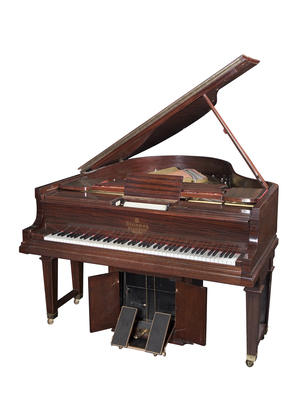Details
TitleReproducing Grand Piano 'Pianola Piano Duo-Art'
PlaceNew York (United States), New York (United States)
Year 1924
Object number0790
Object categorymechanical hammered string instruments
Object namereproducing grand piano, piano with roll
DescriptionReproduction grand pianos are controlled by electricity, but in this case the pedals can also create a driving force. On another piano, to which a recording system was attached, well-known pianists played pieces. The ingenious mechanical-pneumatic recording system ensured that live piano playing was recorded directly on the paper roll. What was special about this was that both the exact metric pattern of all keystrokes was recorded as well as the dynamics - the force of each keystroke - and pedal use. The music played in was corrected, at the pianist's discretion, and then punched onto a paper roll. Playing the roll thus produced a faithful reproduction of the original playing, hence the name reproduction piano. Dynamics in the music are achieved through information on the paper roll. On the sides are extra tracks with holes punched in them that determine for whether the notes should be played harder or softer, slower or faster.
Accompanying textsThe repertoire of this grand piano consists of a large number of rolls with music by a variety of composers, performed by famous pianists of the time. There were mainly classical pieces, but dance music was also popular (sometimes not played in via the reproduction technique but arranged as normal). On some rolls there are also lyrics, so that the person playing the instrument could sing along.
Around 1905, the German firm Welte in Freiburg developed the first reproduction piano. After the success of Welte's reproduction instruments, a competitor named Aeolian entered the market in 1913 with the Duo-Art reproduction piano and grand piano. The term "Duo-Art" is intended to denote the merging of artistic composition with musical interpretation. It proved a great commercial success, partly because of its strong marketing strategy. Indeed, Aeolian contracted several famous pianists who were only allowed to have their playing recorded for Duo-Art. Many thousands of rolls were put into production with live music by Ignacy Paderewsky, Josef Hofmann, Wladimir Horowitz, Sergei Prokofiev, Harold Bauer, Rudolph Ganz, Percy Grainger and George Gershwin, among others.
Around 1905, the German firm Welte in Freiburg developed the first reproduction piano. After the success of Welte's reproduction instruments, a competitor named Aeolian entered the market in 1913 with the Duo-Art reproduction piano and grand piano. The term "Duo-Art" is intended to denote the merging of artistic composition with musical interpretation. It proved a great commercial success, partly because of its strong marketing strategy. Indeed, Aeolian contracted several famous pianists who were only allowed to have their playing recorded for Duo-Art. Many thousands of rolls were put into production with live music by Ignacy Paderewsky, Josef Hofmann, Wladimir Horowitz, Sergei Prokofiev, Harold Bauer, Rudolph Ganz, Percy Grainger and George Gershwin, among others.
Dimensions
geheel height: 100 cm
geheel width: 150 cm
geheel depth: 200 cm
geheel height: 185 cm
geheel width: 150 cm
geheel depth: 200 cm
geheel height: 185 cm
Digital references

